Software Engineering Methodology Research Report Analysis
VerifiedAdded on 2023/03/17
|8
|1758
|21
Report
AI Summary
This report provides an in-depth analysis of software engineering methodologies, focusing on risk management within software projects. It explores various aspects of risk, including identification, classification (project, product, and process risks), and assessment. The report highlights the importance of understanding and mitigating risks to ensure project success, discussing techniques like risk index, risk analysis, and risk assessment. It also covers the classification of risks into internal and external categories, as well as project, technical, and business risks. Furthermore, the report examines both qualitative and quantitative techniques used in risk analysis, such as survey questionnaires and Delphi techniques. The conclusion emphasizes the significance of risk management as an integral part of software project management, outlining key steps like risk assessment and control, and referencing relevant guidelines developed by the project management institute.
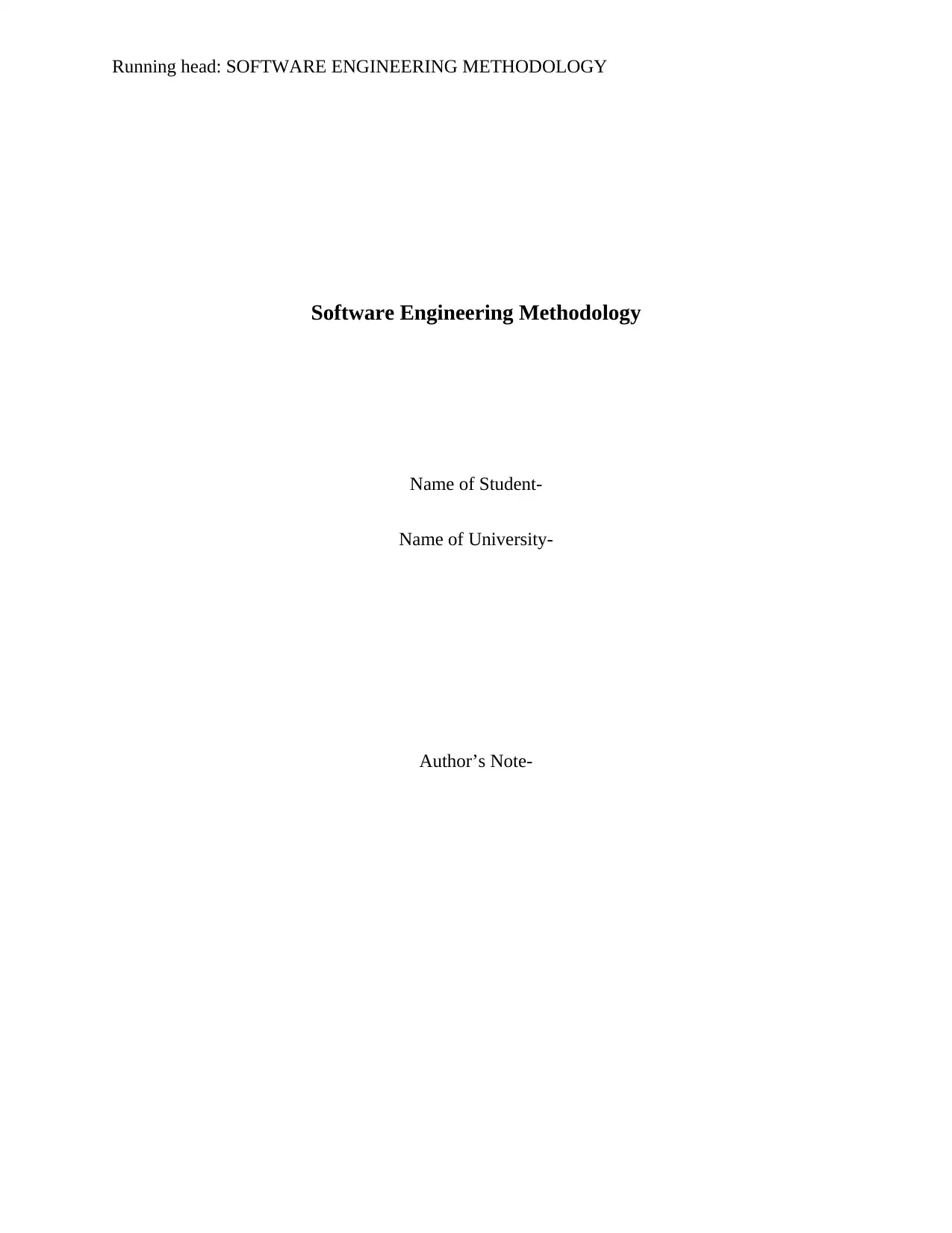
Running head: SOFTWARE ENGINEERING METHODOLOGY
Software Engineering Methodology
Name of Student-
Name of University-
Author’s Note-
Software Engineering Methodology
Name of Student-
Name of University-
Author’s Note-
Paraphrase This Document
Need a fresh take? Get an instant paraphrase of this document with our AI Paraphraser
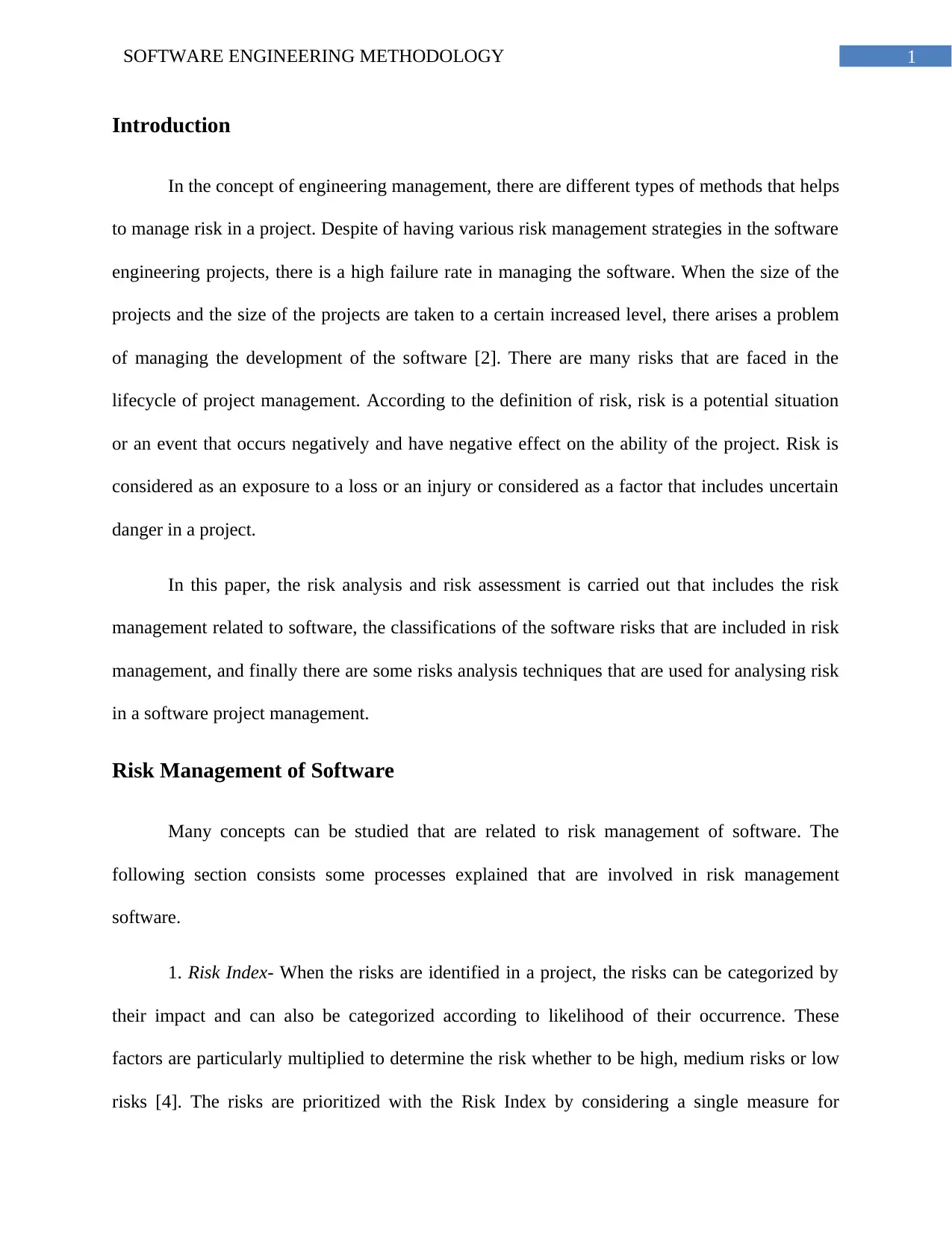
1SOFTWARE ENGINEERING METHODOLOGY
Introduction
In the concept of engineering management, there are different types of methods that helps
to manage risk in a project. Despite of having various risk management strategies in the software
engineering projects, there is a high failure rate in managing the software. When the size of the
projects and the size of the projects are taken to a certain increased level, there arises a problem
of managing the development of the software [2]. There are many risks that are faced in the
lifecycle of project management. According to the definition of risk, risk is a potential situation
or an event that occurs negatively and have negative effect on the ability of the project. Risk is
considered as an exposure to a loss or an injury or considered as a factor that includes uncertain
danger in a project.
In this paper, the risk analysis and risk assessment is carried out that includes the risk
management related to software, the classifications of the software risks that are included in risk
management, and finally there are some risks analysis techniques that are used for analysing risk
in a software project management.
Risk Management of Software
Many concepts can be studied that are related to risk management of software. The
following section consists some processes explained that are involved in risk management
software.
1. Risk Index- When the risks are identified in a project, the risks can be categorized by
their impact and can also be categorized according to likelihood of their occurrence. These
factors are particularly multiplied to determine the risk whether to be high, medium risks or low
risks [4]. The risks are prioritized with the Risk Index by considering a single measure for
Introduction
In the concept of engineering management, there are different types of methods that helps
to manage risk in a project. Despite of having various risk management strategies in the software
engineering projects, there is a high failure rate in managing the software. When the size of the
projects and the size of the projects are taken to a certain increased level, there arises a problem
of managing the development of the software [2]. There are many risks that are faced in the
lifecycle of project management. According to the definition of risk, risk is a potential situation
or an event that occurs negatively and have negative effect on the ability of the project. Risk is
considered as an exposure to a loss or an injury or considered as a factor that includes uncertain
danger in a project.
In this paper, the risk analysis and risk assessment is carried out that includes the risk
management related to software, the classifications of the software risks that are included in risk
management, and finally there are some risks analysis techniques that are used for analysing risk
in a software project management.
Risk Management of Software
Many concepts can be studied that are related to risk management of software. The
following section consists some processes explained that are involved in risk management
software.
1. Risk Index- When the risks are identified in a project, the risks can be categorized by
their impact and can also be categorized according to likelihood of their occurrence. These
factors are particularly multiplied to determine the risk whether to be high, medium risks or low
risks [4]. The risks are prioritized with the Risk Index by considering a single measure for
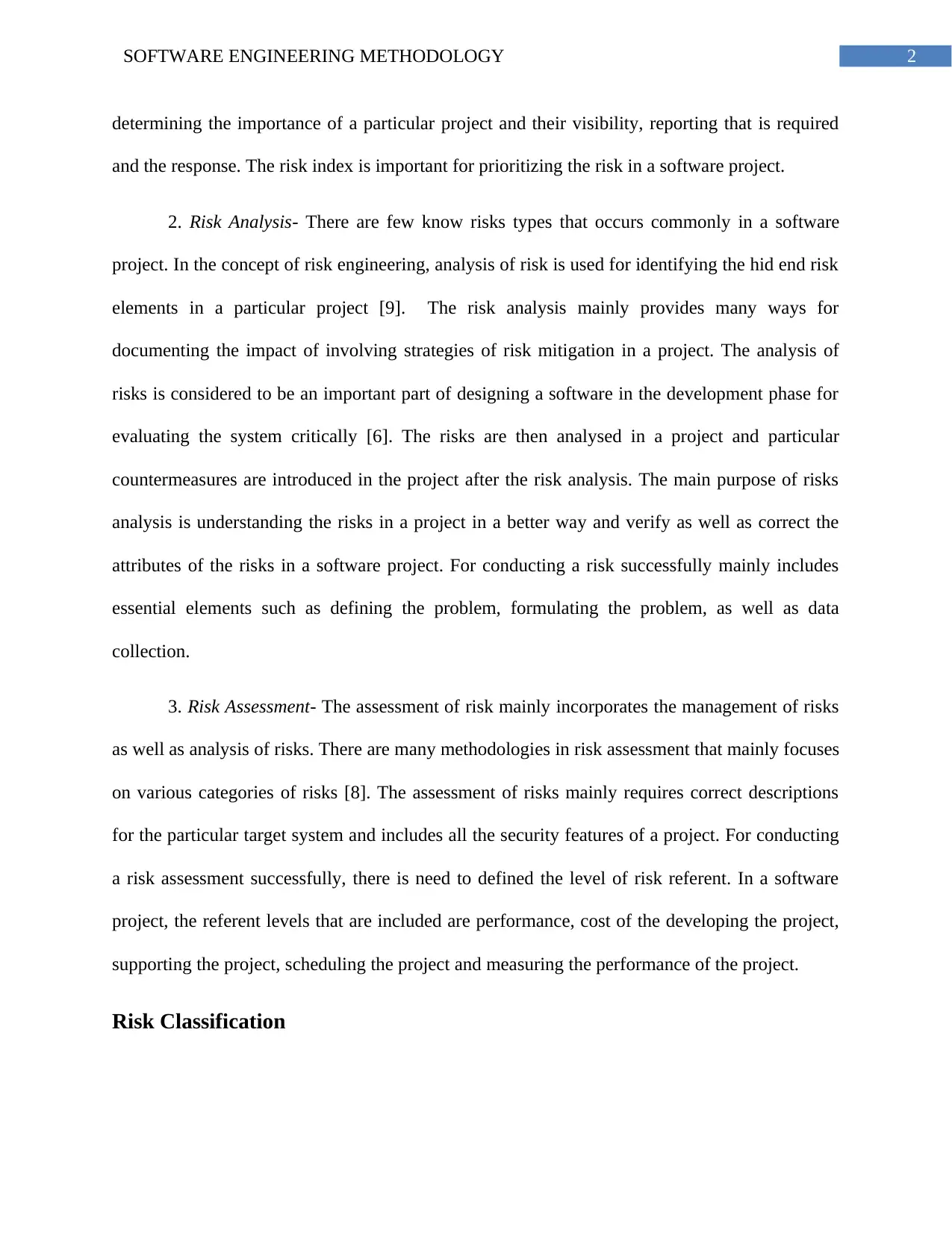
2SOFTWARE ENGINEERING METHODOLOGY
determining the importance of a particular project and their visibility, reporting that is required
and the response. The risk index is important for prioritizing the risk in a software project.
2. Risk Analysis- There are few know risks types that occurs commonly in a software
project. In the concept of risk engineering, analysis of risk is used for identifying the hid end risk
elements in a particular project [9]. The risk analysis mainly provides many ways for
documenting the impact of involving strategies of risk mitigation in a project. The analysis of
risks is considered to be an important part of designing a software in the development phase for
evaluating the system critically [6]. The risks are then analysed in a project and particular
countermeasures are introduced in the project after the risk analysis. The main purpose of risks
analysis is understanding the risks in a project in a better way and verify as well as correct the
attributes of the risks in a software project. For conducting a risk successfully mainly includes
essential elements such as defining the problem, formulating the problem, as well as data
collection.
3. Risk Assessment- The assessment of risk mainly incorporates the management of risks
as well as analysis of risks. There are many methodologies in risk assessment that mainly focuses
on various categories of risks [8]. The assessment of risks mainly requires correct descriptions
for the particular target system and includes all the security features of a project. For conducting
a risk assessment successfully, there is need to defined the level of risk referent. In a software
project, the referent levels that are included are performance, cost of the developing the project,
supporting the project, scheduling the project and measuring the performance of the project.
Risk Classification
determining the importance of a particular project and their visibility, reporting that is required
and the response. The risk index is important for prioritizing the risk in a software project.
2. Risk Analysis- There are few know risks types that occurs commonly in a software
project. In the concept of risk engineering, analysis of risk is used for identifying the hid end risk
elements in a particular project [9]. The risk analysis mainly provides many ways for
documenting the impact of involving strategies of risk mitigation in a project. The analysis of
risks is considered to be an important part of designing a software in the development phase for
evaluating the system critically [6]. The risks are then analysed in a project and particular
countermeasures are introduced in the project after the risk analysis. The main purpose of risks
analysis is understanding the risks in a project in a better way and verify as well as correct the
attributes of the risks in a software project. For conducting a risk successfully mainly includes
essential elements such as defining the problem, formulating the problem, as well as data
collection.
3. Risk Assessment- The assessment of risk mainly incorporates the management of risks
as well as analysis of risks. There are many methodologies in risk assessment that mainly focuses
on various categories of risks [8]. The assessment of risks mainly requires correct descriptions
for the particular target system and includes all the security features of a project. For conducting
a risk assessment successfully, there is need to defined the level of risk referent. In a software
project, the referent levels that are included are performance, cost of the developing the project,
supporting the project, scheduling the project and measuring the performance of the project.
Risk Classification
⊘ This is a preview!⊘
Do you want full access?
Subscribe today to unlock all pages.

Trusted by 1+ million students worldwide
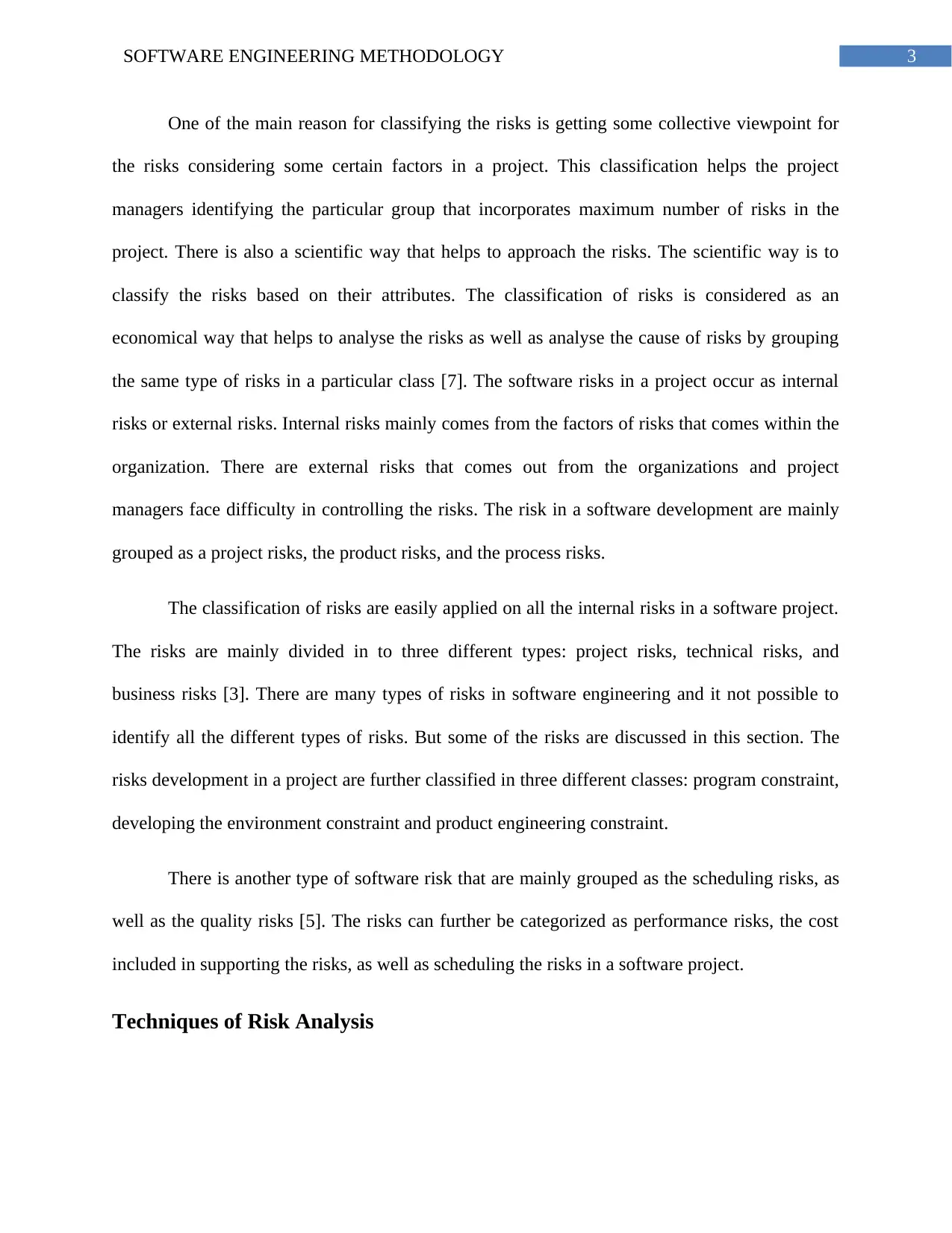
3SOFTWARE ENGINEERING METHODOLOGY
One of the main reason for classifying the risks is getting some collective viewpoint for
the risks considering some certain factors in a project. This classification helps the project
managers identifying the particular group that incorporates maximum number of risks in the
project. There is also a scientific way that helps to approach the risks. The scientific way is to
classify the risks based on their attributes. The classification of risks is considered as an
economical way that helps to analyse the risks as well as analyse the cause of risks by grouping
the same type of risks in a particular class [7]. The software risks in a project occur as internal
risks or external risks. Internal risks mainly comes from the factors of risks that comes within the
organization. There are external risks that comes out from the organizations and project
managers face difficulty in controlling the risks. The risk in a software development are mainly
grouped as a project risks, the product risks, and the process risks.
The classification of risks are easily applied on all the internal risks in a software project.
The risks are mainly divided in to three different types: project risks, technical risks, and
business risks [3]. There are many types of risks in software engineering and it not possible to
identify all the different types of risks. But some of the risks are discussed in this section. The
risks development in a project are further classified in three different classes: program constraint,
developing the environment constraint and product engineering constraint.
There is another type of software risk that are mainly grouped as the scheduling risks, as
well as the quality risks [5]. The risks can further be categorized as performance risks, the cost
included in supporting the risks, as well as scheduling the risks in a software project.
Techniques of Risk Analysis
One of the main reason for classifying the risks is getting some collective viewpoint for
the risks considering some certain factors in a project. This classification helps the project
managers identifying the particular group that incorporates maximum number of risks in the
project. There is also a scientific way that helps to approach the risks. The scientific way is to
classify the risks based on their attributes. The classification of risks is considered as an
economical way that helps to analyse the risks as well as analyse the cause of risks by grouping
the same type of risks in a particular class [7]. The software risks in a project occur as internal
risks or external risks. Internal risks mainly comes from the factors of risks that comes within the
organization. There are external risks that comes out from the organizations and project
managers face difficulty in controlling the risks. The risk in a software development are mainly
grouped as a project risks, the product risks, and the process risks.
The classification of risks are easily applied on all the internal risks in a software project.
The risks are mainly divided in to three different types: project risks, technical risks, and
business risks [3]. There are many types of risks in software engineering and it not possible to
identify all the different types of risks. But some of the risks are discussed in this section. The
risks development in a project are further classified in three different classes: program constraint,
developing the environment constraint and product engineering constraint.
There is another type of software risk that are mainly grouped as the scheduling risks, as
well as the quality risks [5]. The risks can further be categorized as performance risks, the cost
included in supporting the risks, as well as scheduling the risks in a software project.
Techniques of Risk Analysis
Paraphrase This Document
Need a fresh take? Get an instant paraphrase of this document with our AI Paraphraser
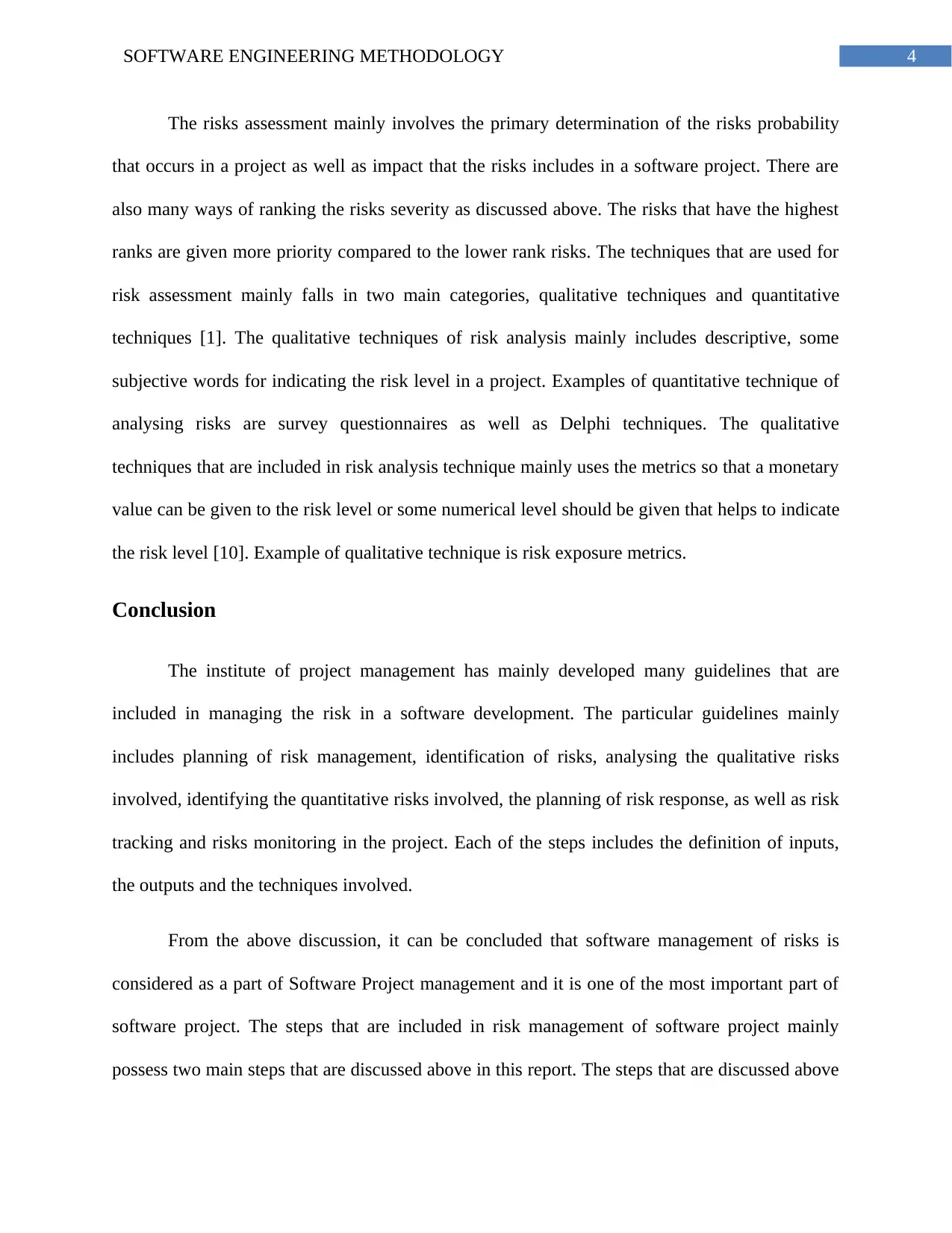
4SOFTWARE ENGINEERING METHODOLOGY
The risks assessment mainly involves the primary determination of the risks probability
that occurs in a project as well as impact that the risks includes in a software project. There are
also many ways of ranking the risks severity as discussed above. The risks that have the highest
ranks are given more priority compared to the lower rank risks. The techniques that are used for
risk assessment mainly falls in two main categories, qualitative techniques and quantitative
techniques [1]. The qualitative techniques of risk analysis mainly includes descriptive, some
subjective words for indicating the risk level in a project. Examples of quantitative technique of
analysing risks are survey questionnaires as well as Delphi techniques. The qualitative
techniques that are included in risk analysis technique mainly uses the metrics so that a monetary
value can be given to the risk level or some numerical level should be given that helps to indicate
the risk level [10]. Example of qualitative technique is risk exposure metrics.
Conclusion
The institute of project management has mainly developed many guidelines that are
included in managing the risk in a software development. The particular guidelines mainly
includes planning of risk management, identification of risks, analysing the qualitative risks
involved, identifying the quantitative risks involved, the planning of risk response, as well as risk
tracking and risks monitoring in the project. Each of the steps includes the definition of inputs,
the outputs and the techniques involved.
From the above discussion, it can be concluded that software management of risks is
considered as a part of Software Project management and it is one of the most important part of
software project. The steps that are included in risk management of software project mainly
possess two main steps that are discussed above in this report. The steps that are discussed above
The risks assessment mainly involves the primary determination of the risks probability
that occurs in a project as well as impact that the risks includes in a software project. There are
also many ways of ranking the risks severity as discussed above. The risks that have the highest
ranks are given more priority compared to the lower rank risks. The techniques that are used for
risk assessment mainly falls in two main categories, qualitative techniques and quantitative
techniques [1]. The qualitative techniques of risk analysis mainly includes descriptive, some
subjective words for indicating the risk level in a project. Examples of quantitative technique of
analysing risks are survey questionnaires as well as Delphi techniques. The qualitative
techniques that are included in risk analysis technique mainly uses the metrics so that a monetary
value can be given to the risk level or some numerical level should be given that helps to indicate
the risk level [10]. Example of qualitative technique is risk exposure metrics.
Conclusion
The institute of project management has mainly developed many guidelines that are
included in managing the risk in a software development. The particular guidelines mainly
includes planning of risk management, identification of risks, analysing the qualitative risks
involved, identifying the quantitative risks involved, the planning of risk response, as well as risk
tracking and risks monitoring in the project. Each of the steps includes the definition of inputs,
the outputs and the techniques involved.
From the above discussion, it can be concluded that software management of risks is
considered as a part of Software Project management and it is one of the most important part of
software project. The steps that are included in risk management of software project mainly
possess two main steps that are discussed above in this report. The steps that are discussed above
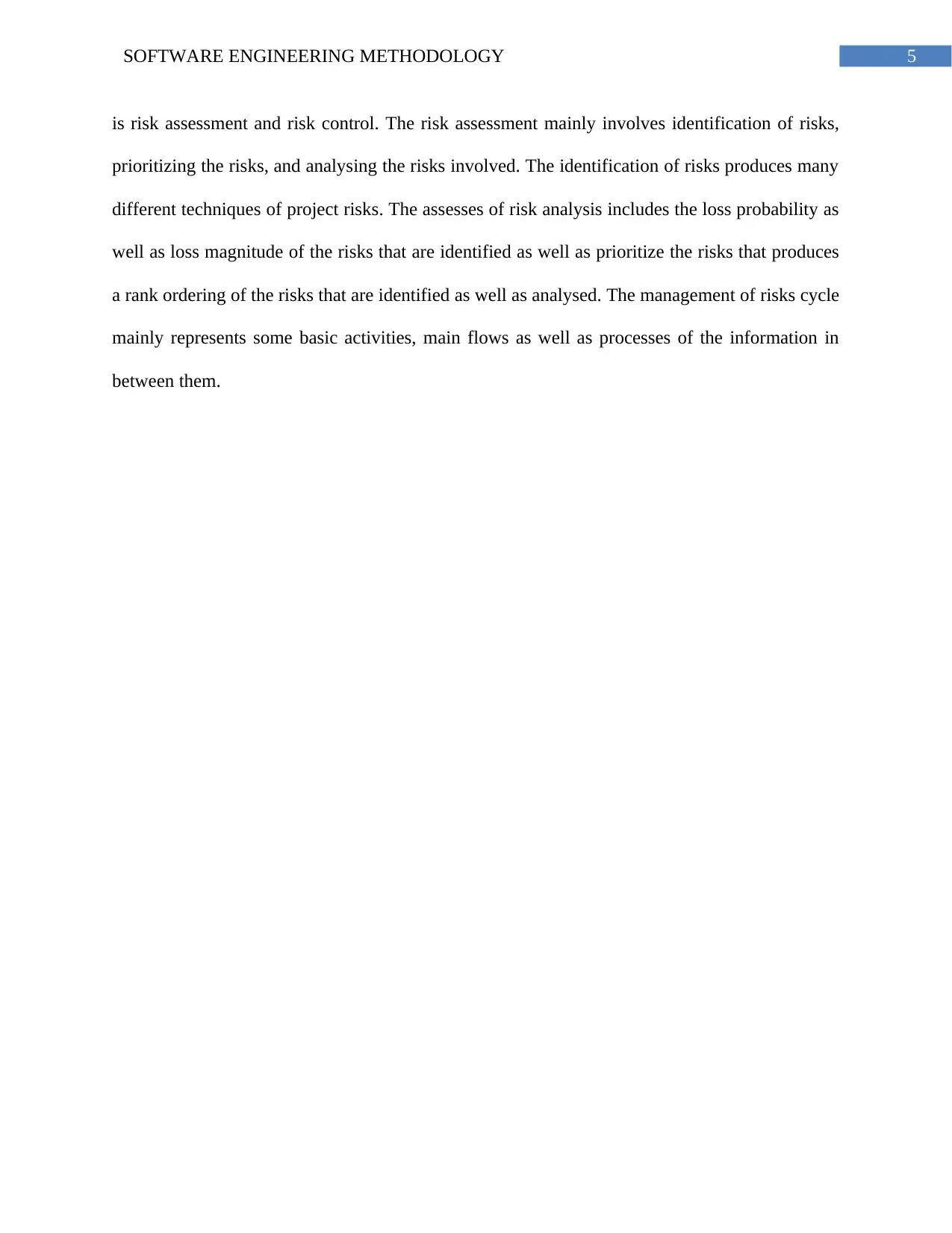
5SOFTWARE ENGINEERING METHODOLOGY
is risk assessment and risk control. The risk assessment mainly involves identification of risks,
prioritizing the risks, and analysing the risks involved. The identification of risks produces many
different techniques of project risks. The assesses of risk analysis includes the loss probability as
well as loss magnitude of the risks that are identified as well as prioritize the risks that produces
a rank ordering of the risks that are identified as well as analysed. The management of risks cycle
mainly represents some basic activities, main flows as well as processes of the information in
between them.
is risk assessment and risk control. The risk assessment mainly involves identification of risks,
prioritizing the risks, and analysing the risks involved. The identification of risks produces many
different techniques of project risks. The assesses of risk analysis includes the loss probability as
well as loss magnitude of the risks that are identified as well as prioritize the risks that produces
a rank ordering of the risks that are identified as well as analysed. The management of risks cycle
mainly represents some basic activities, main flows as well as processes of the information in
between them.
⊘ This is a preview!⊘
Do you want full access?
Subscribe today to unlock all pages.

Trusted by 1+ million students worldwide

6SOFTWARE ENGINEERING METHODOLOGY
References
[1] M. Modarres, M.P. Kaminskiy, and V. Krivtsov, Reliability engineering and risk analysis: a
practical guide. CRC press, 2016.
[2] R.,Mall, Fundamentals of software engineering. PHI Learning Pvt. Ltd. 2018..
[3] M. Niazi, S. Mahmood, M. Alshayeb, M.R. Riaz, K. Faisal, N. Cerpa, S.U. Khan, and I.
Richardson, Challenges of project management in global software development: A client-vendor
analysis. Information and Software Technology, 80, pp.1-19, 2016.
[4] M.M.D. Carvalho, and R. Rabechini Junior, Impact of risk management on project
performance: the importance of soft skills. International Journal of Production Research, 53(2),
pp.321-340, 2015.
[5] M. Hopkinson, The project risk maturity model: Measuring and improving risk management
capability. Routledge, 2017.
[6] Y.Y. Haimes, Risk modeling, assessment, and management. John Wiley & Sons, 2015.
[7] T. Kendrick, Identifying and managing project risk: essential tools for failure-proofing your
project. Amacom, 2015.
[8] Y. Cherdantseva, P. Burnap, A. Blyth, P. Eden, K. Jones, H. Soulsby, and K. Stoddart, A
review of cyber security risk assessment methods for SCADA systems. Computers &
security, 56, pp.1-27, 2016.
[9] M. Modarres, Risk analysis in engineering: techniques, tools, and trends. CRC press, 2016.
References
[1] M. Modarres, M.P. Kaminskiy, and V. Krivtsov, Reliability engineering and risk analysis: a
practical guide. CRC press, 2016.
[2] R.,Mall, Fundamentals of software engineering. PHI Learning Pvt. Ltd. 2018..
[3] M. Niazi, S. Mahmood, M. Alshayeb, M.R. Riaz, K. Faisal, N. Cerpa, S.U. Khan, and I.
Richardson, Challenges of project management in global software development: A client-vendor
analysis. Information and Software Technology, 80, pp.1-19, 2016.
[4] M.M.D. Carvalho, and R. Rabechini Junior, Impact of risk management on project
performance: the importance of soft skills. International Journal of Production Research, 53(2),
pp.321-340, 2015.
[5] M. Hopkinson, The project risk maturity model: Measuring and improving risk management
capability. Routledge, 2017.
[6] Y.Y. Haimes, Risk modeling, assessment, and management. John Wiley & Sons, 2015.
[7] T. Kendrick, Identifying and managing project risk: essential tools for failure-proofing your
project. Amacom, 2015.
[8] Y. Cherdantseva, P. Burnap, A. Blyth, P. Eden, K. Jones, H. Soulsby, and K. Stoddart, A
review of cyber security risk assessment methods for SCADA systems. Computers &
security, 56, pp.1-27, 2016.
[9] M. Modarres, Risk analysis in engineering: techniques, tools, and trends. CRC press, 2016.
Paraphrase This Document
Need a fresh take? Get an instant paraphrase of this document with our AI Paraphraser

7SOFTWARE ENGINEERING METHODOLOGY
[10] F. Tsui, O. Karam, and B. Bernal, Essentials of software engineering. Jones & Bartlett
Learning, 2016.
[10] F. Tsui, O. Karam, and B. Bernal, Essentials of software engineering. Jones & Bartlett
Learning, 2016.
1 out of 8
Related Documents
Your All-in-One AI-Powered Toolkit for Academic Success.
+13062052269
info@desklib.com
Available 24*7 on WhatsApp / Email
![[object Object]](/_next/static/media/star-bottom.7253800d.svg)
Unlock your academic potential
Copyright © 2020–2025 A2Z Services. All Rights Reserved. Developed and managed by ZUCOL.




